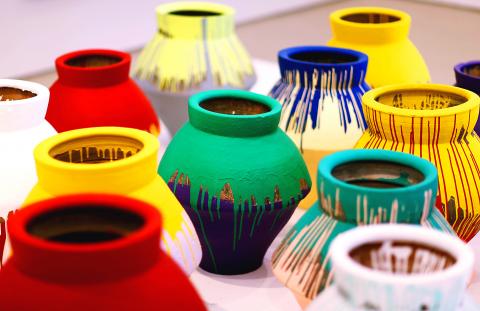Chinese dissident artist Ai Weiwei (艾未未), who helped make his name smashing a valuable vase in the name of art, said Wednesday that he was miffed about another artist destroying one of his vases in Florida.
Maximo Caminero was charged with criminal mischief after destroying a vase valued at US$1 million that was part of Ai’s exhibit at the Perez Art Museum Miami. The Florida artist said he smashed the vase Sunday to protest the institution’s lack of displays of local artists.
Ai said Wednesday that he did not agree with Caminero’s tactic.

Photo: EPA
“Damaging other people’s property or disturbing a public program doesn’t really support his cause,” Ai said in an interview in Beijing.
The urn, dating back about 2,000 years to China’s Han Dynasty, was one of 16 on display that Ai had dipped in bright industrial paint, making them look like much more recently produced pots. The installation aims to “trigger questions about authenticity and the value and meaning of original artwork,” according to the museum’s Web site.
On a wall behind the vases are a series of large photographs of Ai dropping a Han Dynasty ceramic urn that smashed on the floor at his feet, one of his best-known works.
Against this backdrop, Caminero picked up one of the vases from the floor and, when told to put it down, smashed it on the floor, according to a police affidavit citing a security guard. Caminero told officers he broke the vase to protest the museum’s lack of local works, according to the affidavit.
The Miami New Times quoted Caminero as saying it was a spontaneous protest after seeing the photos of Ai breaking the ancient Chinese vase. “I saw it as a provocation by Weiwei to join him in an act of performance protest,” he said.
Ai said the artist’s apparent inspiration was “misleading.”
“You cannot stand in front of a classical painting and kill somebody and say that you are inspired by” the artist, Ai said, adding that “this doesn’t make any sense.”
Caminero apologized Tuesday to The Miami Herald, saying he had no right to destroy someone else’s art. He canceled a planned news conference and did not respond to telephone messages left by The Associated Press. A note on his studio door said his lawyer advised against commenting.
Ai said he thought the value of US$1 million mentioned on the Florida police affidavit was “exaggerated.” He said that he wasn’t involved with the insurance details, but that he thought the figure was “a very ridiculous number.”

Wooden houses wedged between concrete, crumbling brick facades with roofs gaping to the sky, and tiled art deco buildings down narrow alleyways: Taichung Central District’s (中區) aging architecture reveals both the allure and reality of the old downtown. From Indigenous settlement to capital under Qing Dynasty rule through to Japanese colonization, Taichung’s Central District holds a long and layered history. The bygone beauty of its streets once earned it the nickname “Little Kyoto.” Since the late eighties, however, the shifting of economic and government centers westward signaled a gradual decline in the area’s evolving fortunes. With the regeneration of the once

Even by the standards of Ukraine’s International Legion, which comprises volunteers from over 55 countries, Han has an unusual backstory. Born in Taichung, he grew up in Costa Rica — then one of Taiwan’s diplomatic allies — where a relative worked for the embassy. After attending an American international high school in San Jose, Costa Rica’s capital, Han — who prefers to use only his given name for OPSEC (operations security) reasons — moved to the US in his teens. He attended Penn State University before returning to Taiwan to work in the semiconductor industry in Kaohsiung, where he

In February of this year the Taipei Times reported on the visit of Lienchiang County Commissioner Wang Chung-ming (王忠銘) of the Chinese Nationalist Party (KMT) and a delegation to a lantern festival in Fuzhou’s Mawei District in Fujian Province. “Today, Mawei and Matsu jointly marked the lantern festival,” Wang was quoted as saying, adding that both sides “being of one people,” is a cause for joy. Wang was passing around a common claim of officials of the People’s Republic of China (PRC) and the PRC’s allies and supporters in Taiwan — KMT and the Taiwan People’s Party — and elsewhere: Taiwan and

Perched on Thailand’s border with Myanmar, Arunothai is a dusty crossroads town, a nowheresville that could be the setting of some Southeast Asian spaghetti Western. Its main street is the final, dead-end section of the two-lane highway from Chiang Mai, Thailand’s second largest city 120kms south, and the heart of the kingdom’s mountainous north. At the town boundary, a Chinese-style arch capped with dragons also bears Thai script declaring fealty to Bangkok’s royal family: “Long live the King!” Further on, Chinese lanterns line the main street, and on the hillsides, courtyard homes sit among warrens of narrow, winding alleyways and